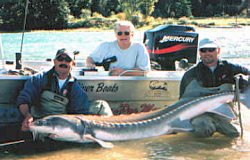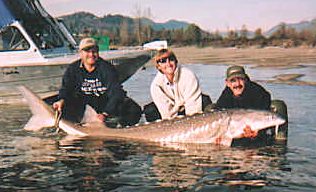|
Once
the salmon season has ended most anglers put away their fishing
gear for the winter. Some will try their luck at steelheading
and some head for the fly tying vise. Spring arrives and those
who headed for the vise will try their luck at some local cutthroat
fishing until ice off on the interior lakes while others wait
for the arrival of the Fraser River salmon in June. Many anglers
are beginning to discover that the rods never need to be put away,
the fresh water Marlin (sturgeon) are abundant year round.

Sturgeon
can be found throughout the Fraser Valley, the Fraser river, Harrison
Lk, Pitt L, Pitt River, Stave R and some tributary sloughs have
sturgeon. These fish can be caught all year though best fishing
is between March & November. It is believed that at some point
in the life cycle, larger sturgeon migrate to the ocean and will
travel to other river systems and ocean estuaries. As to why they
do this, there is much speculation about sturgeon habits, not
much is known about this prehistoric creature. Sturgeon are beginning
to show up in rivers that have never had sturgeon before. One
is the Somass River on Vancouver Island; since 1990 reports of
sturgeon tangled in native nets have been reported. A few years
back, a tagged Columbia River sturgeon was recaptured in Alaska.
It is thought that these migrating sturgeon will return to their
native river for peak fishing periods and spawning.
There
are two major feeding periods when sturgeon fishing is at its
best; April- June and September- November. During the winter months
most fish being caught are smaller, 2 to 4 feet is average. Once
spring sets in, larger fish begin to migrate from Upper Fraser,
Harrison L , Pitt L and the ocean awaiting the arrival of the
eulichan. In April the annual migration of the eulichans begin.
This is the first opportunity for some serious feeding by both
small & larger fish. Size average will increase to 3-5 ft,
and chances of catching those monster trophy size fish are very
good. The second major feeding period is when the sockeye salmon
enter the Fraser, the sturgeon will strategically place themselves
below popular fishing areas and will feed heavily on salmon parts
discarded by anglers. They will also feed on salmon eggs and whole
live and dead fish. This is the last major feeding period before
winter sets in and food becomes scarce so feeding periods are
long and fish are very aggressive towards good baits.

There
are two ways to fish for sturgeon; from a boat or from shore.
Rods and reels used are different for each method. Boat rods are
usually shorter, 6-9 ft one piece rods with a levelwind reels
capable of holding 250- 300 yds of 60- 100 LB test. Shore rods
are 11- 13ft two piece with large spincast reels. The reason for
the longer shore rods in a spincast configuration is castability,
these longer casting rods can launch 12-20 ounces of weight half
across the river. Once you've hooked a fish you will have plenty
of backbone to fight and land a large fish.
The
rigging used from shore is slightly different, we use a three
way swivel attached to the mainline with the weight attached to
the bottom and leader to the middle. When fishing from the boat
the rods are placed at the rear of the boat, the lines are strait
back or slightly off to one side. We use San Francisco sliders
which is a tube made from plastic with a snap attached. The mainline
runs through the tube and tied to a swivel. Then the leader is
attached to the opposite end of the swivel. Place a bead between
the slider and the swivel to allow free movement of the swivel.
With this type of setup the line runs strait through the slider
directly to your bait. The weight sits on the bottom only moving
once the hook is set. Mainline is either monofilement or dacron
60-100lb test and leader strength should be slightly less than
the mainline. I prefer 100 LB Tuffline for mainline and 60-80
mono or dacron for leader. The Tuffline is a smaller diameter
line but maintains superior strength and allows more line capacity
on your reel than mono. Hook size should match the size of bait
being used, 5/0 to 9/0 is the standard. Keeping your hook sharp
is important due to the hard sucker like mouth made mostly of
cartilage.
|
Baits
and location are of great importance to the angler. Using a bait
that's not present in that area is less likely to produce large
fish than using baits that are. During the spring we use eulichans,
lamprey and ditch eels, the later two can be used throughout the
river where the eulichans are used below Chilliwack down to the
mouth of the river. Other baits like headless finn fish, sandshrimp
and dew worms can also be used throughout. The fall fishery provides
good fishing with many baits Salmon gills, salmon roe and the
baits mentioned above all work. Fishing a variety of baits is
the key to finding what's working best that day.
Sturgeon
are bottom feeders. They spend most of their lives cruising in
and out of deep holes in search of food. The river bottom provides
good structure and food sources through these deeper holes. Natural
food will drift down river dropping into and resting on the bottom.
I like to fish several locations in and around these larger holes.
Start by anchoring your boat well above a deep hole. Fish the
flats leading into the deeper water, then re-anchor just above
the deeper water so your bait lies along the drop off area leading
into the hole. Your third anchor drop should be in the deepest
part and the four drop at the back of or leading out of the hole.
This allows you to fish the area thoroughly covering all locations
fish might be actively feeding. If you're fishing the lower area
of the Fraser where tide changes occur, try fishing 2 hours prior
and 2 hours after a high tide for your best bite times. The barometer
also affects fish feeding patterns. A sudden drop in baromic pressure
will stop the larger fish from feeding until stabilization which
occurs in 24 hours to 48 hrs. The drop in pressure doesn't seen
to affect smaller fish and a rise in pressure affects neither.

One
of the most common errors sturgeon anglers make is setting the
hook too early. You must be patient. Wait for the bite to be a
steady pulsating pull, not small quick pulls. If you can't stand
to watch those small quick bites try picking up the rod and holding
it. Wait until the rod is being pulled steadily down. Drop your
rod tip as the fish is pulling down then pull up setting the hook
with authority. Patience is the key to success. Sometimes the
fish will give a couple small tugs then nothing. Don't reel in
your rod, just wait and he will return for another taste. When
fishing peak feeding periods such as the Spring Eulichan migration,
bites can be ferocious. A good rod holder is a valuable tool;
one with a large enough opening to allow you to pick up the rod
when a fish is spooling line. Equally important is a fighting
belt made from leather or plastic They help tremendously when
trying to reel in a large fish and also work well for the younger
kids when fishing for salmon. Last, but just as important as any
tool, is a lasso for landing large fish. It should be made from
a soft material that leaves no scares.
We
are so fortunate to have all the angling opportunities we have
in the Fraser Valley. We must continue to practice good river
edict and release practices to ensure our fisheries future. Many
people spend countless hours behind closed doors negotiating for
your right to fish, to ensure angling opportunities exist in the
future. There is a proposed bait ban for the Fraser River. As
of Aug 31/99 which will affect your ability to catch Sturgeon.
The Fraser Valley Salmon Society is one group of many who dedicate
their time to protect the rights of anglers of all denominations
and species. By joining one of the many groups your name will
be counted and your voice can be heard, if you so wish. The fishing
industry is going through dramatic changes and we the sport anglers
are now beginning to get the recognition we've lacked for many
years. Now more than ever we need all sport anglers to be counted.
By putting your name on a piece of paper, you would be helping
yourselves and those working hard, to preserve your ability to
fish in the future.
Goodluck
and we will see you on the river!
Vic Carrao
STS Guiding Service
(604) 826-3028

|







